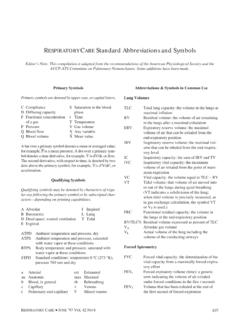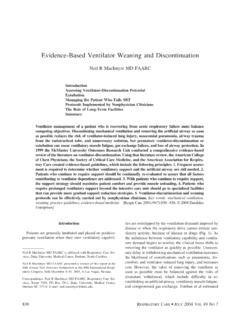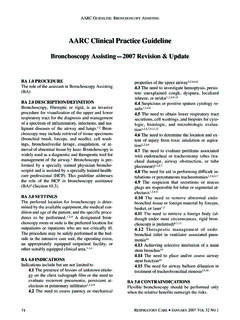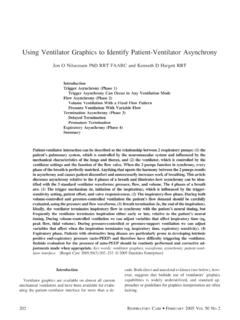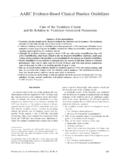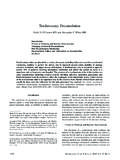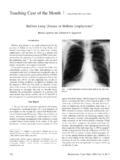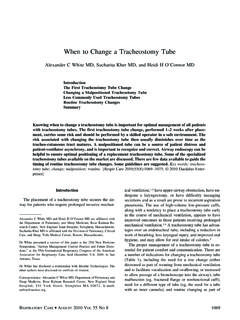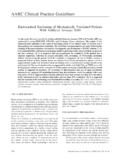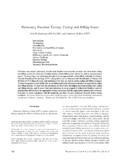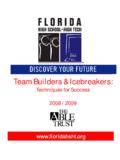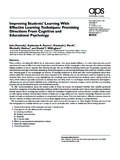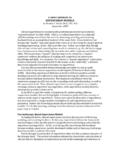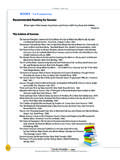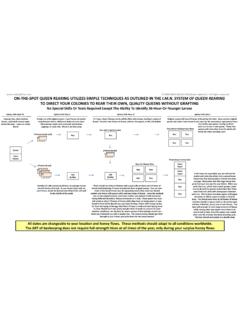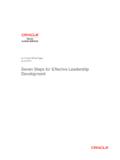Transcription of Technique and the Rapid Shallow Breathing Index
1 Technique and the Rapid Shallow Breathing Index No practice has changed more dramatically during my balance,1 such as upper-airway obstruction or central-ner- career than ventilator weaning. My training in the late vous-system ,11 High RSBIs occur more com- 1980s and early 1990s was often spent at the bedside, monly in the elderly and women with small endotracheal debating whether to wean, when to do it, and which tech- tubes, suggesting that different thresholds for success might nique to use. Experts touted diverse modes and testing be ,13 Finally, practice variation may under- parameters, some rational, some not. mine the RSBI: some respiratory therapists use a T-piece, Fortunately, critical care has evolved since then. The some use continuous positive airway pressure (CPAP), dangers of prolonged intubation are widely recognized, and some use pressure support to measure the RSBI, all of along with mandates to liberate patients quickly once which could impact the measurements Unfor- respiratory failure The focus on gradual wean- tunately, variation in the way the RSBI has been used ing has shifted to using spontaneous Breathing trials for since its original description precludes a simple summary promptly identifying extubation Weaning pro- statement regarding its value and tocols administered by non-physicians have achieved a status close to standard of ,4.
2 A diverse array of screening tests have long played a SEE THE ORIGINAL STUDY ON PAGE 1462. role in Perhaps the most extensively investi- gated is the Rapid - Shallow - Breathing Index (RSBI), which In this issue of RESPIRATORY CARE, Patel and colleagues reflects the respiratory pattern adopted by many patients investigated 3 important technical issues that might influ- who fail weaning ,7 In its classic description,7 wean- ence the Using a convenience sample of 60 MICU. ing candidates in the medical intensive care unit (MICU) patients eligible for weaning after 72 hours of mechanical were disconnected from the ventilator and breathed through ventilation, the investigators compared the RSBI measured a T-piece. Using a Wright spirometer, the RSBI was cal- (1) at different times of the day, (2) using digital output on culated by dividing the respiratory rate (in breaths/min) by the ventilator versus a Wright spirometer, and (3) during the tidal volume (measured in liters).
3 Compared to other T-piece Breathing versus CPAP of 5 cm H2O. Time of day parameters, an RSBI 105 breaths/min/L demonstrated a and measurement Technique did not affect RSBI. In con- superior combination of sensitivity (97%), specificity trast, CPAP decreased the median RSBI from 90 breaths/. (64%), positive predictive value (78%), and negative pre- min/L with the T-piece to 71 breaths/min/L, indicating that dictive value (95%) when predicting weaning success. The positive pressure mitigated Rapid Shallow Breathing . Im- RSBI was also attractive because it was unaffected by portantly, the switch from one Technique to the other would patient effort, simple to measure, and easy to remember, significantly impact the number of patients for whom the especially when rounded off to 100. RSBI would predict weaning success. The RSBI has since been applied to diverse populations Patel and colleagues' carefully done study adds clarity and settings, incorporated into weaning protocols, and used to the weaning literature.
4 Prior work has also shown that to predict outcomes ranging from tolerance of decreased ventilator support can decrease the RSBI. For example, in ventilator support to weaning to Although postoperative cardiac surgery patients, CPAP decreased many embrace the RSBI, others have questioned its value, the RSBI by 49%.16 In another study, both CPAP of leading to substantial debate about its ,5,8,9 5 cm H2O and pressure-support ventilation at 5 cm H2O. The calculation and utility of the RSBI vary signifi- lowered the Approximately one third of those cantly with the population studied, the question asked, and with an RSBI 105 breaths/min/L with ventilator support the measurement Technique used. With its high sensitivity had an RSBI 105 breaths/min/L with a T-piece. None of and negative predictive value, the Index is most accurate these patients were extubated successfully, leading the au- when used to identify patients likely to fail weaning, as thors to recommend that the RSBI be used only if mea- opposed to those likely to succeed.
5 The positive predictive sured similar to the way it was originally value decreases after a week of mechanical The results of these studies, along with the present one The RSBI's value is limited when respiratory failure is by Patel and colleagues, should come as no surprise. It caused by problems besides pulmonary strength-load im- would be na ve to think that changes in measurement tech- RESPIRATORY CARE NOVEMBER 2009 VOL 54 NO 11 1449. Technique AND THE Rapid Shallow Breathing Index . nique would not impact the results and value of a diag- trials of weaning from mechanical ventilation. Am Rev Respir Dis nostic ,19 In chronic obstructive pulmonary disease, 1986;134(6):1111-1118. 7. Yang KL, Tobin MJ. A prospective study of indexes predicting the extrinsic positive end-expiratory pressure has long been outcome of trials of weaning from mechanical ventilation.
6 N Engl known to decrease work of Breathing by mitigating intrin- J Med 1991;324(21):1445-1450. sic positive end-expiratory pressure,20-22 which in turn 8. Tobin MJ, Jubran A. Meta-analysis under the spotlight: focused on might decrease the respiratory load as well as the RSBI. In a meta-analysis of ventilator weaning. Crit Care Med 2008;36(1): congestive heart failure, positive pressure can improve car- 1-7. 9. Tanios MA, Nevins ML, Hendra KP, Cardinal P, Allan JE, Naumova diac function,23 which could also lower the RSBI. EN, et al. A randomized, controlled trial of the role of weaning How should the RSBI be used then, if at all? Whether an predictors in clinical decision-making. Crit Care Med 2006;34(10): RSBI is even necessary if a spontaneous Breathing trial is 2530-2535. going to be done anyway remains However, 10.
7 Epstein SK. Etiology of extubation failure and the predictive value of when used as originally described,7 particularly in MICU the Rapid Shallow Breathing Index . Am J Respir Crit Care Med 1995;. patients given no ventilatory support, a high RSBI would 152(2):545-549. 11. Ko R, Ramos L, Chalela J. Conventional weaning parameters do not still be expected to portend weaning failure. Patel and predict extubation failure in neurocritical care patients. Neurocrit colleagues have shown us convincingly that changes in Care 2009;10(3):269-273. measurement Technique can substantially change the re- 12. Epstein SK, Ciubotaru RL. Influence of gender and endotracheal sults of this classic test. However, if used, the RSBI should tube size on preextubation Breathing pattern. Am J Respir Crit Care be measured using the carefully described techniques that Med 1996;154(6 Pt 1):1647-1652.
8 13. Krieger BP, Isber J, Breitenbucher A, Throop G, Ershowsky P. Serial have stood the test of nearly 20 years. measurements of the Rapid - Shallow - Breathing Index as a predictor of Mark D Siegel MD weaning outcome in elderly medical patients. Chest 1997;112(4): 1029-1034. Pulmonary and Critical Care Section 14. Soo Hoo GW, Park L. Variations in the measurement of weaning Department of Internal Medicine parameters. Chest 2002;121(6):1947-1955. Yale School of Medicine 15. Patel KN, Ganatra KD, Bates JHT, Young MP. Variation in the Rapid New Haven, Connecticut Shallow Breathing Index associated with common measurement tech- niques and conditions. Respir Care 2009;54(11):1462-1466. 16. El-Khatib MF, Jamaleddine GW, Khoury AR, Obeid MY. Effect of continuous positive airway pressure on the Rapid Shallow Breathing REFERENCES.
9 Index in patients following cardiac surgery. Chest 2002;121(2):475- 1. Hall JB, Wood LDH. Liberation of the patient from mechanical 479. ventilation. JAMA 1987;257(12):1621-1628. 17. El-Khatib MF, Zeineldine SM, Jamaleddine GW. Effect of pressure 2. Ely EW, Baker AM, Dunagan DP, Burke HL, Smith AC, Kelly PT, support ventilation and positive end expiratory pressure on the Rapid et al. Effect on the duration of mechanical ventilation of identifying Shallow Breathing Index in intensive care unit patients. Intensive patients capable of Breathing spontaneously. N Engl J Med 1996; Care Med 2008;34(3):505-510. 335(25):1864-1869. 18. Jaeschke RZ, Meade MO, Guyatt GH, Keenan SP, Cook DJ. How to 3. Ely EW, Meade MO, Haponik EF, Kollef MH, Cook DJ, Guyatt GH, use diagnostic test articles in the intensive care unit: diagnosing et al.
10 Mechanical ventilator weaning protocols driven by nonphysi- weanability using f/Vt. Crit Care Med 1997;25(9):1514-1521. cian health-care professionals. Chest 2001;120(6 Suppl):454S-463S. 19. Krieger BP, Campos M. Weaning parameters: read the methodology 4. MacIntyre NR. Evidence-based guidelines for weaning and discon- before proceeding. Chest 2002;122(6):1873-1874. tinuing ventilatory support. Chest 2001;120(6 Suppl):375S-396S. 20. Smith TC, Marini JJ. Impact of PEEP on lung mechanics and work 5. Meade M, Guyatt G, Cook D, Griffith L, Sinuff T, Kergl C, et al. of Breathing in severe airflow obstruction. J Appl Physiol 1988;. Predicting success in weaning from mechanical ventilation. Chest 65(4):1488-1499. 2001;120(6 Suppl):400S-424S. 21. Sydow M, Golisch W, Buscher H, Zinserling J, Crozier TA, Bur- 6. Tobin MJ, Perez W, Guenther SM, Semmes BJ, Mador MJ, Allen SJ, chardi H.
